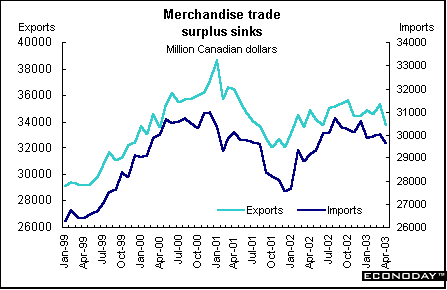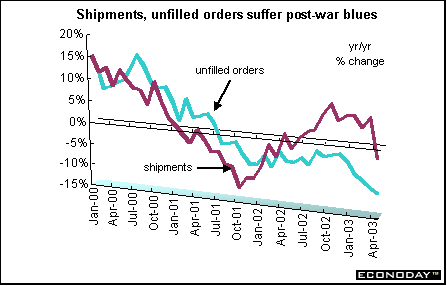
Indicator scoreboard
Germany - April seasonally adjusted industrial production sank 1.0 percent and was down 0.3 percent when compared with last year. Most categories were down lead by capital goods, off 2.8 percent and consumer durables down 2.5 percent. Continued fighting in Iraq at the beginning of the month plus the late Easter holiday may have curbed production. Excluding construction, industrial output fell 1.1 percent in April. These data are used by Eurostat to compute eurozone industrial production. West German industrial output fell 1.1 percent after dropping 0.4 percent in March. In east Germany, production dropped 0.7 percent after jumping 2.6 percent in March.

April seasonally adjusted merchandise trade surplus was €9.5 billion, up from €8.5 billion in March. Exports were down 2.2 percent and 0.4 percent on the year. Imports were down 4.8 percent and 0.8 percent on the year.
May wholesale prices were down 0.8 percent and 0.2 percent when compared with last year. Excluding oil products, wholesale prices fell 0.4 percent and 0.1 percent on the year. Seasonal food prices plunged 8.7 percent and 1.9 percent on the year. Excluding seasonal food prices, wholesale prices fell 0.5 percent and 0.1 percent on the year.
France - April seasonally adjusted industrial output slumped 0.3 percent and 0.6 percent when compared with last year. Manufacturing output dropped 0.8 percent and 0.6 percent on the year. All categories with the exception of consumer goods dropped.

April seasonally adjusted merchandise trade surplus rose to €591 million from €122 million in March. Exports inched up 0.3 percent while imports dropped 1.5 percent. The drop in consumer and semi-finished goods imports outweighed the purchase of a Boeing aircraft.
Italy - First quarter real, seasonally and workday adjusted gross domestic product edged down 0.1 percent and was up 0.8 percent when compared with last year. The GDP data were workday adjusted for the first time, bringing Italian GDP statistics fully into line with the other large eurozone countries. All components were down or unchanged with the exception of inventories.

April seasonally and workday adjusted industrial production was up 0.6 percent and 2.6 percent when compared with last year. Consumer goods output rose 1.4 percent, investment goods climbed 2.3 percent, and intermediate goods gained 0.6 percent, while energy goods were up 0.3 percent.
Britain - May output producer price index was unchanged and up 1.3 percent when compared with last year. Falling oil prices were offset by increases in the prices of tobacco and alcohol products. Input producer prices were unchanged but up 1.1 percent on the year. Excluding food, beverages, tobacco and gas, the output price index was up 0.1 percent and 1.3 percent from a year ago.

April seasonally adjusted industrial production rose 0.2 percent but was down 1.8 percent when compared with last year. Manufacturing production was unchanged but down 1.2 percent on the year. Mining and quarrying were down as was oil extraction. However, production of durable, non-durable and investment goods were up on the month.

April global merchandise trade goods deficit narrowed to Stg3.089 billion from Stg3.380 billion in March. A sharp rise in exports to non-European Union countries in spite of a significant widening in the deficit with EU countries was the reason for the decline. In volume terms, excluding oil and erratic items, exports to non-EU countries rose 18.4 percent and imports were down 0.3 percent. The value of exports to the EU was down 5.9 percent while imports rose 1.2 percent. The deficit excluding oil and erratic items was Stg3.411 billion.

May claimant count unemployment rose 9,700, the largest increase in the jobless count since December 1992 and the fourth consecutive monthly increase. However the claimant unemployment rate remained at 3.1 percent. The ILO measure of unemployment rose in the three months February though April by 36,000 when compared with the previous three months (January through March). The ILO unemployment rate also remained stable at 5.1 percent. ILO employment rose 51,000 and the employment rate remained stable at 59.8 percent.

April average earnings rose by 3.2 percent, down from 3.4 percent in March. The decline was due primarily to the drop in bonuses. Pay growth excluding bonuses fell from 3.7 percent to 3.4 percent over the same period. The difference between pay growth including and excluding bonuses was greatest in private sector services. Pay growth excluding bonuses fell due to the timing of Easter which reduced the amount of overtime in the manufacturing and business services sectors in April 2003 when compared with April 2002. In the public sector the headline rate of earnings growth rose from 5.1 percent in March to 5.2 percent in April. Private sector earnings growth fell from 3.0 percent in March to 2.7 percent in April.

Asia
Australia - May employment climbed by 29,000 jobs, all of which were full time. The unemployment rate slipped to 6 percent from 6.1 percent in April. The unemployment rate has ranged between 6 percent and 6.2 percent since July after falling from 7 percent in January 2002. Full-time employment rose 37,200 while part-time jobs declined by 8,200. The participation rate, which measures the proportion of working-aged people with jobs or looking for employment, was unchanged at 64 percent.

Japan - First quarter seasonally adjusted revised gross domestic product rose 0.1 percent and was up 0.8 percent when compared with last year. Revised data showed capital spending rose just 0.7 percent compared with an initial estimate of a 1.9 increase.

May seasonally adjusted corporate goods price index fell 0.6 percent and was down 1.5 percent when compared with last year. The index sank primarily because of petroleum and coal prices. Only prices for iron and steel and processed foodstuffs increased on the month.
Americas
Canada - April merchandise trade surplus fell from C$5.3 billion in March to C$4.1 billion in April. The reason was the largest decline in merchandise exports in more than two years and was almost entirely due to energy. Exports plummeted 4.5 percent, the largest monthly decline since February 2001. Meanwhile, imports fell 1.3 percent to a 12-month low. Exports to the United States, which accounted for 83 percent of the total, fell 4.5 percent to C$28.1 billion, again the biggest monthly decline since February 2001. Imports from the United States fell 0.8 percent to C$20.5 billion, accounting for most of the total drop. The trade surplus with the United States fell by C$1.1 billion to C$7.6 billion. This was an almost complete reversal the previous month, which had the largest monthly increase in almost a year.

April manufacturers' shipments declined 3.4 percent. Fifteen of 21 industries, representing 68 percent of total shipments, pulled back production in April. This was underscored by the steep decline in prices of petroleum and coal products, coupled with the second drop in three months for the motor vehicle industry. Excluding the price-impacted petroleum and coal products industry and the recently volatile motor vehicle and parts industries, shipments contracted by 1.5 percent in April. Nondurable shipments sank 4.3 percent, primarily due to lower shipments of petroleum products. Durable goods shipments dropped 2.7 percent. The anticipation of the war in Iraq in the months leading up to April contributed to record high petroleum prices and, subsequently, to the price-inflated value of shipments for petroleum and coal products. As the war effort drew to a swift close, petroleum prices fell substantially, lessening the impact of the price-effect on manufacturing overall. Although the outbreak of the SARS in Toronto posed a significant blow to the health care and hospitality sectors, the impact on manufacturing seems to have been negligible to date. Unfilled orders fell 1.9 percent. Following three consecutive increases, new orders sank 4.5 percent. Fewer orders for machinery, computers and motor vehicle parts contributed to the drop.

 |


Last Week's Highlights • Global
Stock Market Indexes • Recap of Global Markets
• Currencies • Indicator
Scoreboard

The Bottom Line •
Looking Ahead
|